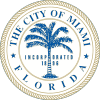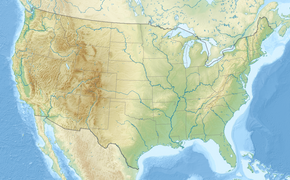Miami
Miami is a city located on the southeastern part of the U.S. state of Florida. It is a known tourist stop and it is well known for its Cuban, Puerto Rican and Haitian culture. Miami has one of the largest Hispanic communities in the United States, with over 70% of the population being of Hispanic and Latino American descent. Miami is also the county seat (and largest city) of Miami-Dade County.
Miami | |
|---|---|
|
| |
| Nicknames: The 305, Magic City, Gateway to the Americas, Gateway to Latin America, Capital of Latin America[1] and Vice City | |
 Interactive map outlining Miami | |
| Coordinates: 25°47′N 80°13′W / 25.78°N 80.21°W[2] | |
| Country | |
| State | |
| County | |
| Settled | After 1858[a] |
| Incorporated | July 28, 1896 |
| Founded by | Julia Tuttle |
| Named for | Miami River, ultimately derived from Mayaimi |
| Government | |
| • Type | Mayor–Commission |
| • Mayor | Francis Suarez (R) |
| Area | |
| • Total | 56.07 sq mi (145.23 km2) |
| • Land | 36.00 sq mi (93.23 km2) |
| • Water | 20.08 sq mi (52.00 km2) |
| • Metro | 6,137 sq mi (15,890 km2) |
| Elevation | 6 ft (1.8 m) |
| Highest elevation | 42 ft (12.8 m) |
| Population | |
| • Total | 442,241 |
| • Estimate (2023)[6] | 455,924 |
| • Rank | 42nd in the United States 2nd in Florida |
| • Density | 12,284.47/sq mi (4,743.55/km2) |
| • Urban | 6,077,522 (US: 4th) |
| • Urban density | 4,884.8/sq mi (1,886.0/km2) |
| • Metro | 6,091,747 (US: 9th) |
| Demonym | Miamian |
| Time zone | UTC– 05:00 (EST) |
| • Summer (DST) | UTC– 04:00 |
| ZIP Codes | List
|
| Area code(s) | 305, 786, 645 |
| FIPS code | 12-45000 |
| GNIS feature ID | 277593, 2411786 |
| GDP (Miami-Dade County, 2021) | $155 billion[9] (14th) |
| GMP (Metro, 2021) | $403 billion[10][11] (12th) |
| Website | miamigov.com |
Miami is nicknamed "The Magic City" because of its rapid growth.
History
changeThe Tequesta tribe lived in what is now Miami before Spain claimed it. In 1566, Pedro Menéndez de Avilés, Florida's first governor, claimed the area from the Tequesta for Spain. Spain ruled Florida until Spain gave it to the United States in 1821. Florida became a state in 1845. On July 28, 1896, Miami officially became a city. It was named after the Mayaimi tribe.
Miami experienced rapid growth during the Florida land boom of the 1920s. However, this land boom was affected by the 1926 Miami hurricane. Many Cubans migrated to Miami after Fidel Castro rose to power in Cuba following the 1959 Cuban Revolution, and the population rapidly increased. The majority of these Cuban immigrants now live in Little Havana.
During the 1980s, Miami was a primary location for drug trafficking from South America, mainly Colombia. This brought in millions of dollars into the city's economy, and it allowed the construction of luxury hotels, skyscrapers, nightclubs and car dealerships.[12]
Climate
changeMiami has a tropical monsoon climate. Summers have average temperatures of 33 °C (91 °F) during the day and 25 °C (77 °F) at night, with average monthly rainfall around 8 in (200 mm). Winters have average temperatures of 25 °C (77 °F) during the day and 16 °C (61 °F) at night, with average monthly rainfall around 2 in (51 mm).
Education
changeMiami-Dade County Public Schools is the school district for public schools in Miami. There are also some private schools there. There are many colleges and universities in and around Miami. A few of these include: Florida International University, University of Miami, Miami Dade College, and Florida Atlantic University.
Sports
changeThere are several professional sports teams that play in and around Miami, including the Miami Marlins of Major League Baseball, the Miami Heat of the National Basketball Association, the Florida Panthers of the National Hockey League, the Miami Dolphins of the National Football League, and Inter Miami CF of Major League Soccer.
Also, three universities in and around Miami are members of NCAA Division I, the top division of college sports in the U.S.:
- Miami Hurricanes, in the suburb of Coral Gables – Atlantic Coast Conference
- FIU Panthers, in the city of Miami – Sun Belt Conference; moved to Conference USA in July 2013
- Florida Atlantic Owls, in Boca Raton – Sun Belt Conference
Demographics
changeThe population of Miami, Florida as of 2011 is 1.3 million, with 41.4% suffering from poverty. According to the DNA North American Studies Institute, the racial-makeup of Miami is:
"Others" includes Asians and Arabs, among others.
References
change- ↑ "Miami: the Capital of Latin America". Time. December 2, 1993. Archived from the original on December 24, 2007.
- ↑ "US Gazetteer files: 2020". United States Census Bureau. March 25, 2021. Retrieved March 25, 2021.
- ↑ George, Paul S. (1996). "Miami: Three Hundred Years of History". HistoryMiami. Archived from the original on July 28, 2021. Retrieved May 28, 2021.
- ↑ Shappee, Nathan D. (1961). "Fort Dallas and the Naval Depot on Key Biscayne, 1836–1926" (PDF). Tequesta. 21: 13–40. Archived from the original (PDF) on August 26, 2021. Retrieved May 28, 2021 – via Florida International University Digital Collections.
- ↑ "2020 U.S. Gazetteer Files". United States Census Bureau. Retrieved October 31, 2021.
- ↑ 6.0 6.1 "Quickfacts: Miami city, Florida". United States Census Bureau. Retrieved August 26, 2024.
- ↑ "List of 2020 Census Urban Areas". census.gov. United States Census Bureau. Archived from the original on January 14, 2023. Retrieved January 8, 2023.
- ↑ "2020 Population and Housing State Data". United States Census Bureau. Archived from the original on August 24, 2021. Retrieved August 22, 2021.
- ↑ "Gross Domestic Product by County, 2021" (PDF). Bureau of Economic Analysis. December 9, 2020. Retrieved December 9, 2020.
- ↑ "GDP and Personal Income". U.S. Bureau of Economic Analysis. Retrieved August 3, 2021.
- ↑ "U.S. metro areas – ranked by Gross Metropolitan Product (GMP) 2021". Statista.
- ↑ "City of Miami History". archive.miamigov.com. Archived from the original on July 29, 2021. Retrieved March 30, 2021.
- Notes
- ↑ Bahamians were farming along the Miami River before 1830. Richard Fitzpatrick established a plantation there in 1830, but abandoned it when the Second Seminole War (1835–1843) began. The U.S. Army established Fort Dallas there in 1836, but left the fort in 1841. William English reopened Fitzpatrick's plantation after the war and sold city lots, but left the area at the end of the 1840s. The Army returned to the fort in 1849–1851, and again for the Third Seminole War (1855–1858).[3][4]
Other websites
change- City of Miami official site Archived 2006-08-08 at the Wayback Machine









